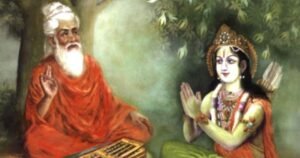By: Smt. Sunanda Ananth

Sai Baba frequently advised devotees to read Yoga Vasistha and to follow it in their lives. Sai Baba pointed out that amid the peace and tranquility that prevailed in Ayodhya, Prince Rama once found traces of sorrow among people. He pondered questions such as: What is the meaning of life which consists of sorrows? How can one end the repetitive nature of this life? Is liberation possible, how? As if to answer his questions, Sage Vishwamitra persuaded Rama’s father King Dashrath to let the prince accompany him to the forest. Sage Vishwamitra, who wanted the young prince to receive the best education, took him to Sage Vasishta, one of the Saptarishis. From Vasishta, Rama received Vedantic knowledge and emerged enlightened. The dialogue between Sage Vasishta and Rama is the central theme of ‘Yoga Vasishta’, a great philosophical text, believed to have been written by Sage Valmiki.
Sai Maharaj associated Dasganu Maharaj and Dada Kelkar to interpret Yoga Vasistha. Capturing the essence of Vedanta, Yoga Vasishta is a storehouse of Atma Jnana, the highest spiritual knowledge, but it is not easily accessible to all. Baba insisted that one must pass through four gates to access its wisdom: i.e., Shanti, mind at peace; Trupti or Santosha, contentment; Satsang, association of the wise; and Atma Vichara, self-enquiry. Baba told his devotees that even if we keep the company of one of these, we are sure to be introduced to the other three.

The first qualification is the mind that is pure, perfect, and always at peace. Mind projects false notions of ‘I’, and ego, and creates differences and diversities. We are disturbed when our mind is turned outward, and we become peaceful when the mind is turned inward. Most of our problems arise because we identify ourselves with the mind. Addressing Rama, Sage Vasishta says: “He who wears the armor of self-control becomes knowledgeable and reaches the highest state of excellence. He whose mind is at peace is free from dualities such as likes and dislikes, attachment and aversions, pleasure and pain.” Yoga Vasishta recommends yoga to control and quieten the mind.
Entry to the second gate is possible for those who find happiness in being content. Lasting happiness comes not by acquiring more but by renouncing the needless. It is best to be satisfied with what one has. We should indeed be ambitious enough to reach a higher goal, but if we are not content with what we have, we will only end up in regret.
The third gate underscores the importance of Satsang, keeping the company of the wise, the spiritually evolved. In the verses of ‘Bhaja Govindam’, Adi Shankaracharya says: “From Satsang, association with the learned, comes non-attachment, from non-attachment comes freedom from delusion and freedom comes self-awareness which paves a contact with sages one can reach the highest state of spiritual fulfillment.
The fourth gate advises us to do ‘Atma Vichara’, self-inquiry. If we intensely search within and inquire who we are, we will realize that we are neither the body nor the mind. The body will perish one day, and the mind is merely a bundle of thoughts. The intense Self-enquiry would lead us to the realization that we are the ever-existing Self, which gives us the consciousness of our existence.

Leave a Reply